2001 NISSAN X-TRAIL coolant
[x] Cancel search: coolantPage 3791 of 3833
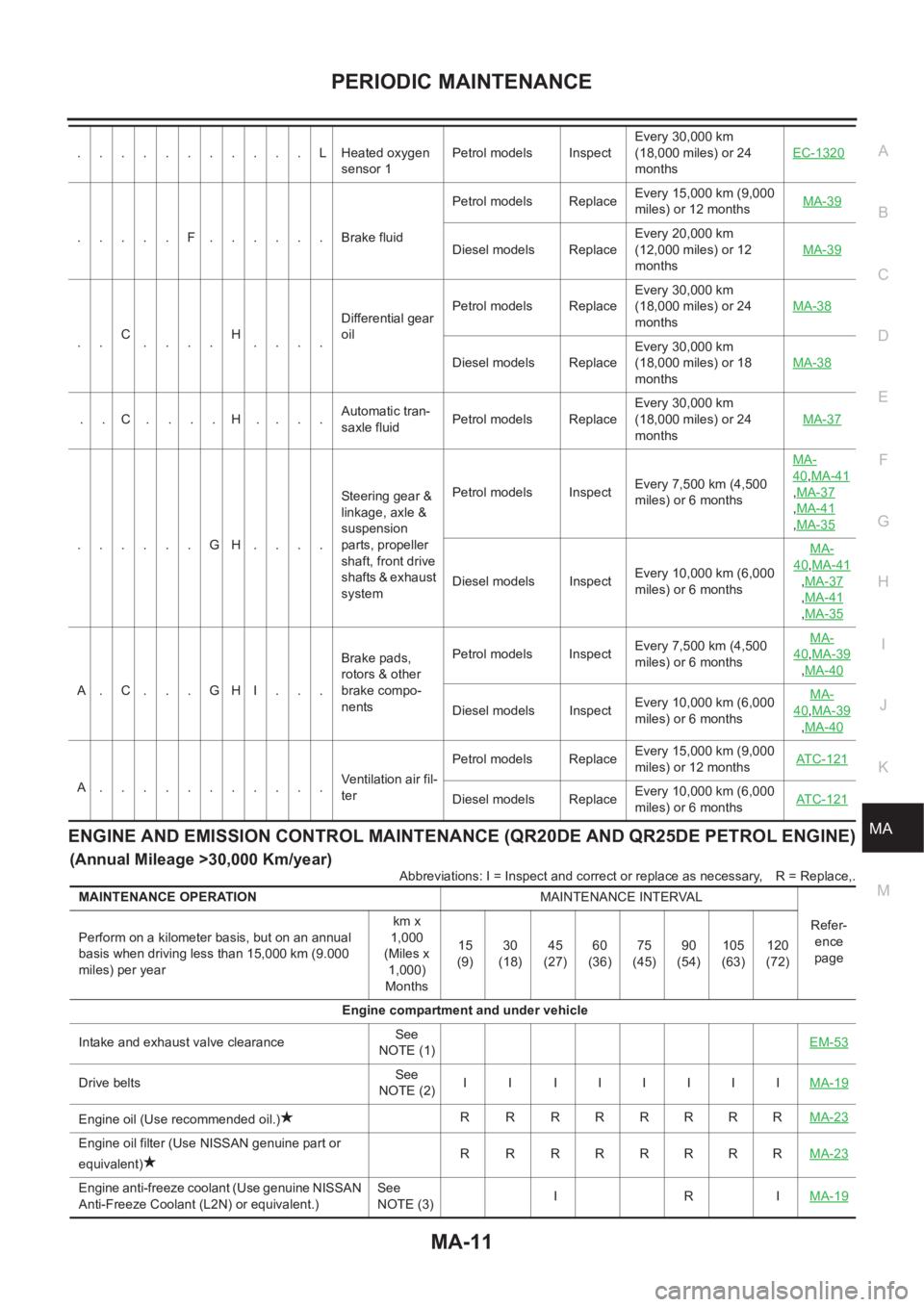
PERIODIC MAINTENANCE
MA-11
C
D
E
F
G
H
I
J
K
MA
B
MAENGINE AND EMISSION CONTROL MAINTENANCE (QR20DE AND QR25DE PETROL ENGINE)
(Annual Mileage >30,000 Km/year)
Abbreviations: I = Inspect and correct or replace as necessary,R = Replace,. ...........LHeated oxygen
sensor 1Petrol models InspectEvery 30,000 km
(18,000 miles) or 24
monthsEC-1320
.....F......Brake fluidPetrol models ReplaceEvery 15,000 km (9,000
miles) or 12 monthsMA-39Diesel models ReplaceEvery 20,000 km
(12,000 miles) or 12
monthsMA-39
..C
....H
....Differential gear
oilPetrol models ReplaceEvery 30,000 km
(18,000 miles) or 24
monthsMA-38
Diesel models ReplaceEvery 30,000 km
(18,000 miles) or 18
monthsMA-38
..C....H....Automatic tran-
saxle fluidPetrol models ReplaceEvery 30,000 km
(18,000 miles) or 24
monthsMA-37
......GH....Steering gear &
linkage, axle &
suspension
parts, propeller
shaft, front drive
shafts & exhaust
systemPetrol models InspectEvery 7,500 km (4,500
miles) or 6 monthsMA-
40,MA-41
,MA-37
,MA-41
,MA-35
Diesel models InspectEvery 10,000 km (6,000
miles) or 6 monthsMA-
40,MA-41
,MA-37
,MA-41
,MA-35
A.C...GHI...Brake pads,
rotors & other
brake compo-
nentsPetrol models InspectEvery 7,500 km (4,500
miles) or 6 monthsMA-
40,MA-39
,MA-40
Diesel models InspectEvery 10,000 km (6,000
miles) or 6 monthsMA-40,MA-39
,MA-40
A...........Ventilation air fil-
terPetrol models ReplaceEvery 15,000 km (9,000
miles) or 12 monthsAT C - 1 2 1Diesel models ReplaceEvery 10,000 km (6,000
miles) or 6 monthsAT C - 1 2 1
MAINTENANCE OPERATIONMAINTENANCE INTERVAL
Refer-
ence
page Perform on a kilometer basis, but on an annual
basis when driving less than 15,000 km (9.000
miles) per yearkm x
1,000
(Miles x
1,000)
Months15
(9)30
(18)45
(27)60
(36)75
(45)90
(54)105
(63)120
(72)
Engine compartment and under vehicle
Intake and exhaust valve clearanceSee
NOTE (1)EM-53
Drive beltsSee
NOTE (2)II IIIIIIMA-19
Engine oil (Use recommended oil.)R RRRRRRRMA-23
Engine oil filter (Use NISSAN genuine part or
equivalent)R RRRRRRRMA-23
Engine anti-freeze coolant (Use genuine NISSAN
Anti-Freeze Coolant (L2N) or equivalent.)See
NOTE (3)IRIMA-19
Page 3793 of 3833
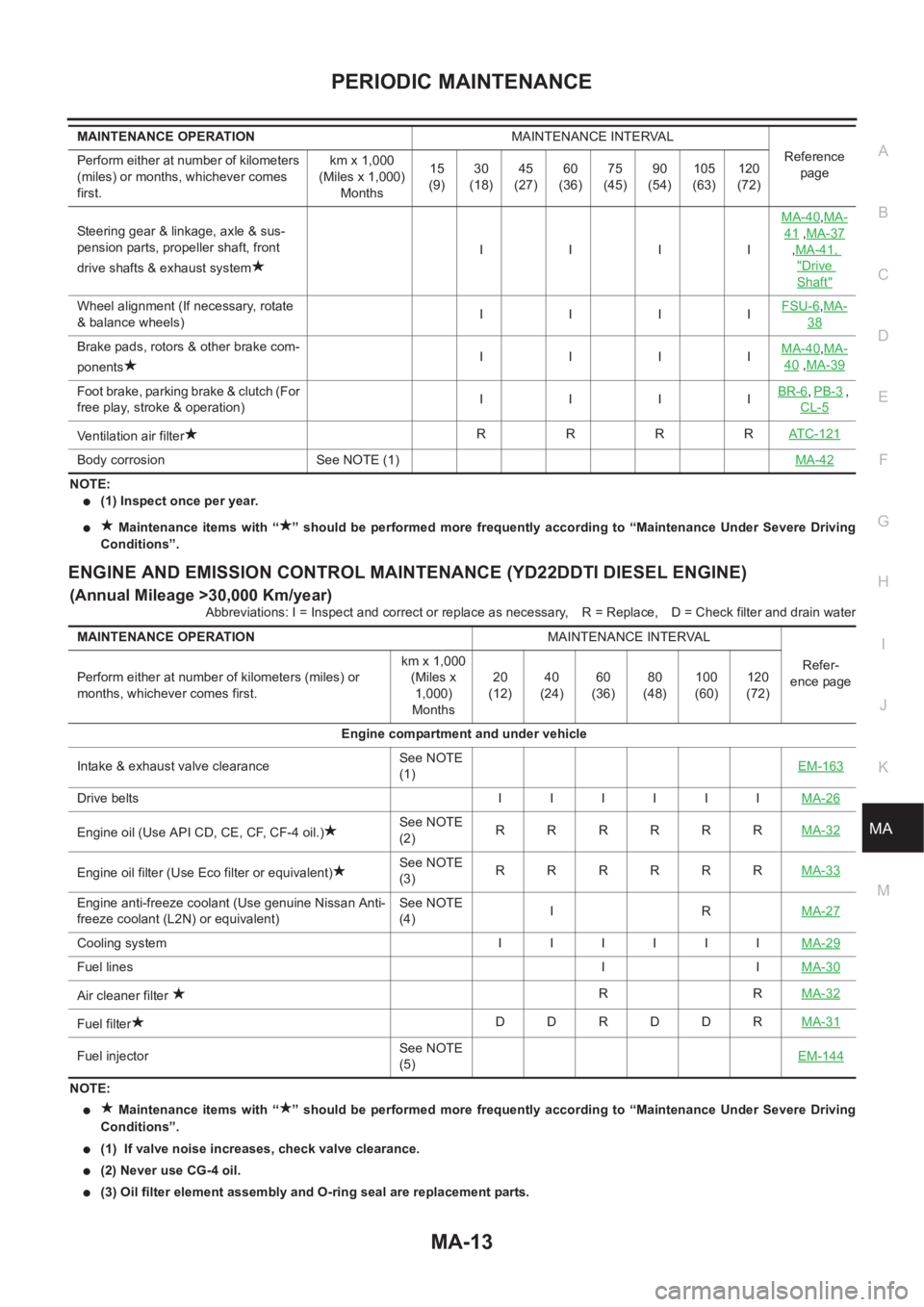
PERIODIC MAINTENANCE
MA-13
C
D
E
F
G
H
I
J
K
MA
B
MA
NOTE:
●(1) Inspect once per year.
● Maintenance items with “ ” should be performed more frequently according to “Maintenance Under Severe Driving
Conditions”.
ENGINE AND EMISSION CONTROL MAINTENANCE (YD22DDTI DIESEL ENGINE)
(Annual Mileage >30,000 Km/year)
Abbreviations: I = Inspect and correct or replace as necessary,R = Replace, D = Check filter and drain water
NOTE:
● Maintenance items with “ ” should be performed more frequently according to “Maintenance Under Severe Driving
Conditions”.
●(1) If valve noise increases, check valve clearance.
●(2) Never use CG-4 oil.
●(3) Oil filter element assembly and O-ring seal are replacement parts. Steering gear & linkage, axle & sus-
pension parts, propeller shaft, front
drive shafts & exhaust systemIIIIMA-40
,MA-
41 ,MA-37
,MA-41,
"Drive
Shaft"
Wheel alignment (If necessary, rotate
& balance wheels)IIIIFSU-6,MA-
38
Brake pads, rotors & other brake com-
ponentsIIIIMA-40,MA-
40 ,MA-39
Foot brake, parking brake & clutch (For
free play, stroke & operation)IIIIBR-6,PB-3 ,
CL-5
Ventilation air filterRRRRAT C - 1 2 1
Body corrosion See NOTE (1)MA-42
MAINTENANCE OPERATIONMAINTENANCE INTERVAL
Reference
page Perform either at number of kilometers
(miles) or months, whichever comes
first.km x 1,000
(Miles x 1,000)
Months15
(9)30
(18)45
(27)60
(36)75
(45)90
(54)105
(63)120
(72)
MAINTENANCE OPERATIONMAINTENANCE INTERVAL
Refer-
ence page Perform either at number of kilometers (miles) or
months, whichever comes first.km x 1,000
(Miles x
1,000)
Months20
(12)40
(24)60
(36)80
(48)100
(60)120
(72)
Engine compartment and under vehicle
Intake & exhaust valve clearanceSee NOTE
(1)EM-163
Drive belts I I I I I IMA-26
Engine oil (Use API CD, CE, CF, CF-4 oil.)See NOTE
(2)RRRRRRMA-32
Engine oil filter (Use Eco filter or equivalent)See NOTE
(3)RRRRRRMA-33
Engine anti-freeze coolant (Use genuine Nissan Anti-
freeze coolant (L2N) or equivalent)See NOTE
(4)IRMA-27
Cooling system I I I I I IMA-29
Fuel linesIIMA-30
Air cleaner filter RRMA-32
Fuel filterDDRDDRMA-31
Fuel injectorSee NOTE
(5)EM-144
Page 3796 of 3833
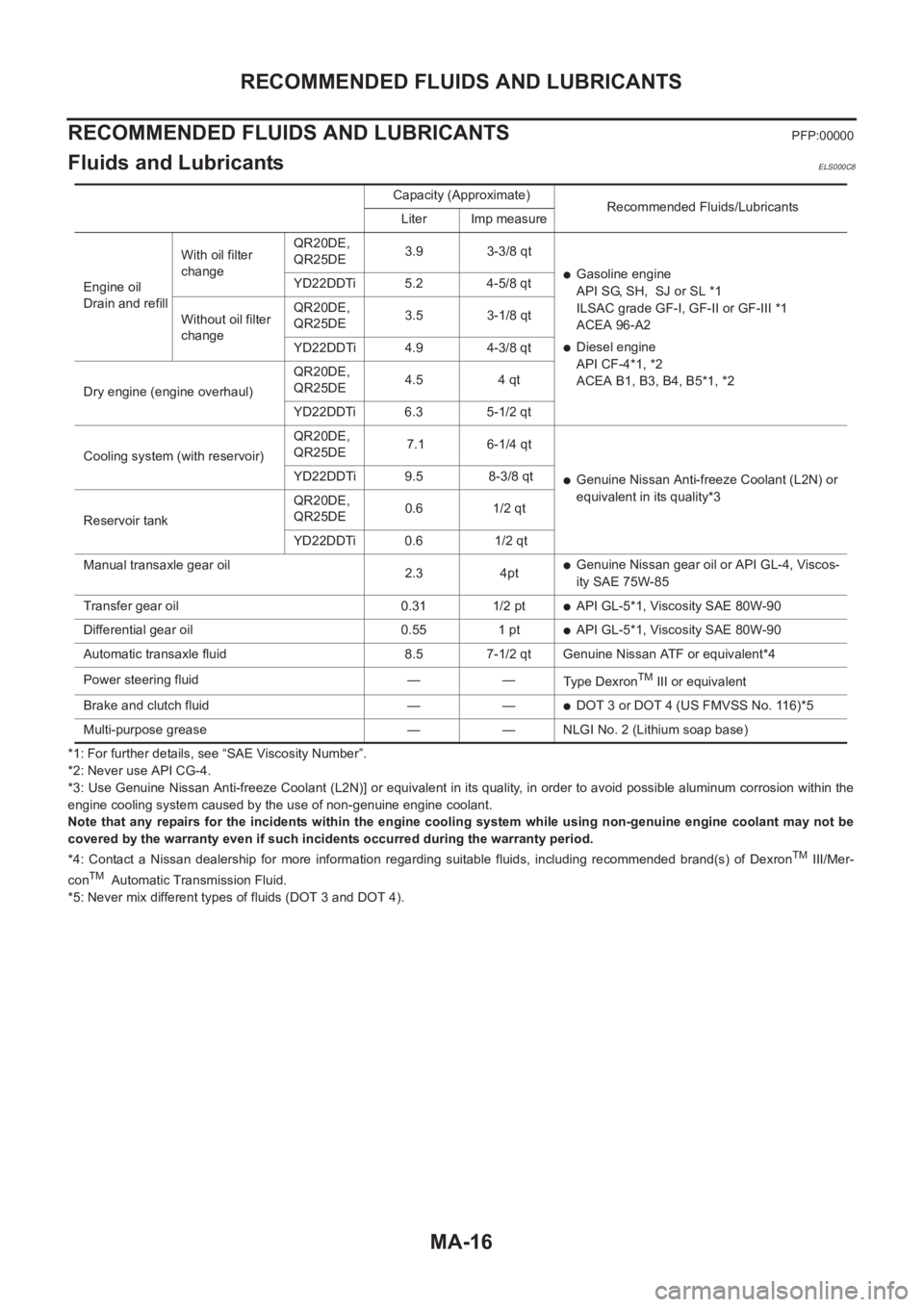
MA-16
RECOMMENDED FLUIDS AND LUBRICANTS
RECOMMENDED FLUIDS AND LUBRICANTS
PFP:00000
Fluids and LubricantsELS000C8
*1: For further details, see “SAE Viscosity Number”.
*2: Never use API CG-4.
*3: Use Genuine Nissan Anti-freeze Coolant (L2N)] or equivalent in its quality, in order to avoid possible aluminum corrosion within the
engine cooling system caused by the use of non-genuine engine coolant.
Note that any repairs for the incidents within the engine cooling system while using non-genuine engine coolant may not be
covered by the warranty even if such incidents occurred during the warranty period.
*4: Contact a Nissan dealership for more information regarding suitable fluids, including recommended brand(s) of Dexron
TM III/Mer-
conTM Automatic Transmission Fluid.
*5: Never mix different types of fluids (DOT 3 and DOT 4).Capacity (Approximate)
Recommended Fluids/Lubricants
Liter Imp measure
Engine oil
Drain and refillWith oil filter
changeQR20DE,
QR25DE3.9 3-3/8 qt
●Gasoline engine
API SG, SH, SJ or SL *1
ILSAC grade GF-I, GF-II or GF-III *1
ACEA 96-A2
●Diesel engine
API CF-4*1, *2
ACEA B1, B3, B4, B5*1, *2 YD22DDTi 5.2 4-5/8 qt
Without oil filter
changeQR20DE,
QR25DE3.5 3-1/8 qt
YD22DDTi 4.9 4-3/8 qt
Dry engine (engine overhaul)QR20DE,
QR25DE4.5 4 qt
YD22DDTi 6.3 5-1/2 qt
Cooling system (with reservoir)QR20DE,
QR25DE 7.1 6-1/4 qt
●Genuine Nissan Anti-freeze Coolant (L2N) or
equivalent in its quality*3 YD22DDTi 9.5 8-3/8 qt
Reservoir tankQR20DE,
QR25DE0.6 1/2 qt
YD22DDTi 0.6 1/2 qt
Manual transaxle gear oil
2.3 4pt
●Genuine Nissan gear oil or API GL-4, Viscos-
ity SAE 75W-85
Transfer gear oil 0.31 1/2 pt
●API GL-5*1, Viscosity SAE 80W-90
Differential gear oil 0.55 1 pt
●API GL-5*1, Viscosity SAE 80W-90
Automatic transaxle fluid 8.5 7-1/2 qt Genuine Nissan ATF or equivalent*4
Power steering fluid — —
Type Dexron
TM III or equivalent
Brake and clutch fluid — —
●DOT 3 or DOT 4 (US FMVSS No. 116)*5
Multi-purpose grease — — NLGI No. 2 (Lithium soap base)
Page 3798 of 3833
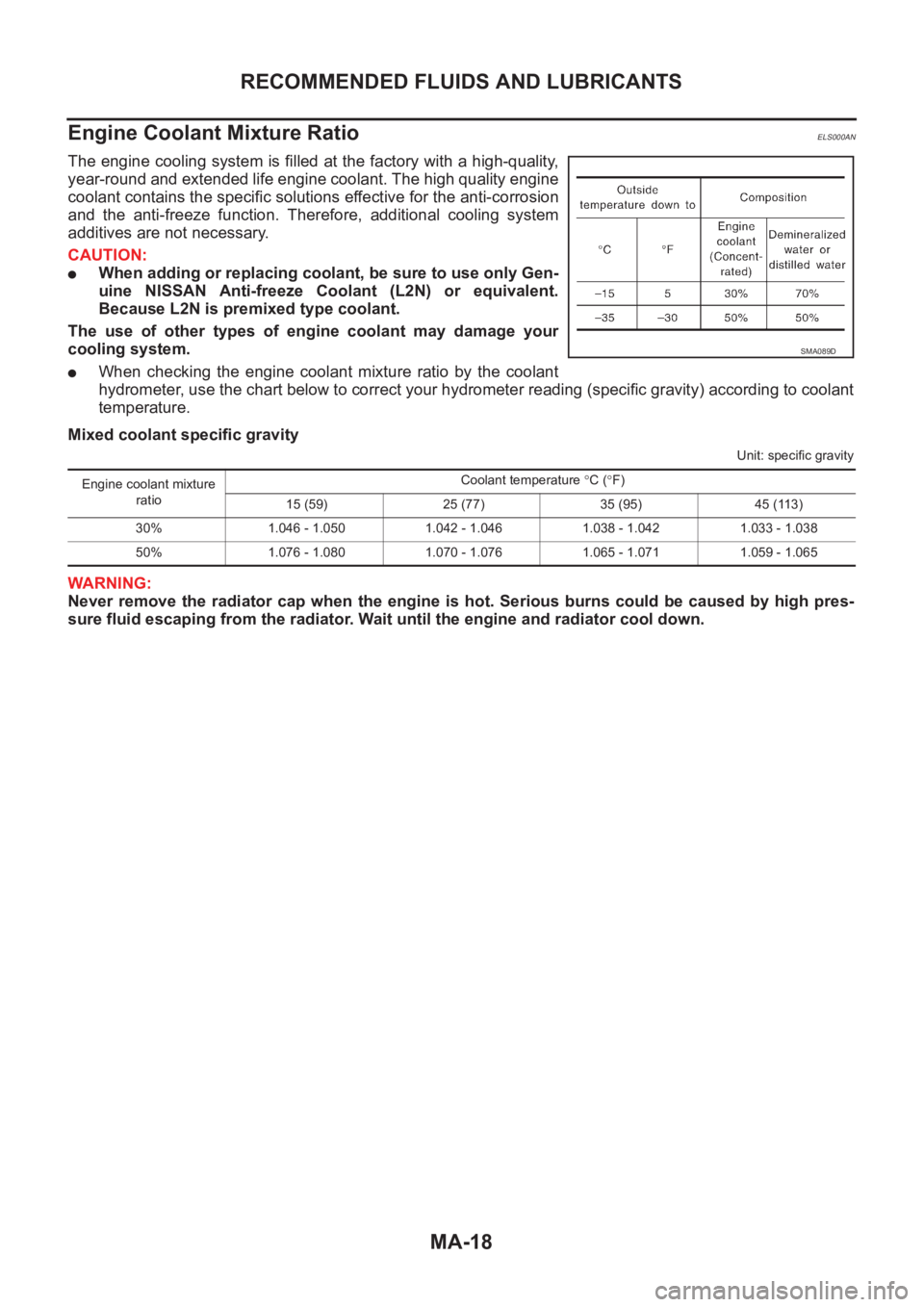
MA-18
RECOMMENDED FLUIDS AND LUBRICANTS
Engine Coolant Mixture Ratio
ELS000AN
The engine cooling system is filled at the factory with a high-quality,
year-round and extended life engine coolant. The high quality engine
coolant contains the specific solutions effective for the anti-corrosion
and the anti-freeze function. Therefore, additional cooling system
additives are not necessary.
CAUTION:
●When adding or replacing coolant, be sure to use only Gen-
uine NISSAN Anti-freeze Coolant (L2N) or equivalent.
Because L2N is premixed type coolant.
The use of other types of engine coolant may damage your
cooling system.
●When checking the engine coolant mixture ratio by the coolant
hydrometer, use the chart below to correct your hydrometer reading (specific gravity) according to coolant
temperature.
Mixed coolant specific gravity
Unit: specific gravity
WARNING:
Never remove the radiator cap when the engine is hot. Serious burns could be caused by high pres-
sure fluid escaping from the radiator. Wait until the engine and radiator cool down.
SMA089D
Engine coolant mixture
ratioCoolant temperature °C (°F)
15 (59) 25 (77) 35 (95) 45 (113)
30% 1.046 - 1.050 1.042 - 1.046 1.038 - 1.042 1.033 - 1.038
50% 1.076 - 1.080 1.070 - 1.076 1.065 - 1.071 1.059 - 1.065
Page 3799 of 3833

ENGINE MAINTENANCE (QR20DE·QR25DE)
MA-19
C
D
E
F
G
H
I
J
K
MA
B
MA
ENGINE MAINTENANCE (QR20DE·QR25DE) PFP:00100
Checking Drive BeltsELS000KA
WARNING:
Be sure to perform when the engine is stopped.
●Make sure that the indicator (single line notch on fixed side) of drive belt auto-tensioner is within the pos-
sible use range (between three line notches on moving side).
NOTE:
●Check the drive belt auto-tensioner indicator (single line notch on fixed side) when the engine is cold.
●When the new drive belt is installed, the indicator (single line notch on fixed side) should be within the
range A.
●Visually check entire belt for wear, damage or cracks.
●If the indicator (single line notch on fixed side) is out of possible use range or belt is damaged, replace the
belt.
Tension AdjustmentELS000K4
Belt tensioning is not necessary, as it is automatically adjusted by drive belt auto-tensioner.
Changing Engine CoolantELS000JV
WARNING:
●To avoid being scalded, never change the engine coolant when the engine is hot.
●Wrap a thick cloth around cap and carefully remove the cap. First, turn the cap a quarter of a turn
to release built-up pressure. Then turn the cap all the way.
DRAINING ENGINE COOLANT
1. Open radiator drain plug at the bottom of radiator, and remove
radiator cap.
●Be careful not to allow engine coolant to contact drive belts.
PBIC1234E
PBIC0236E
Page 3800 of 3833
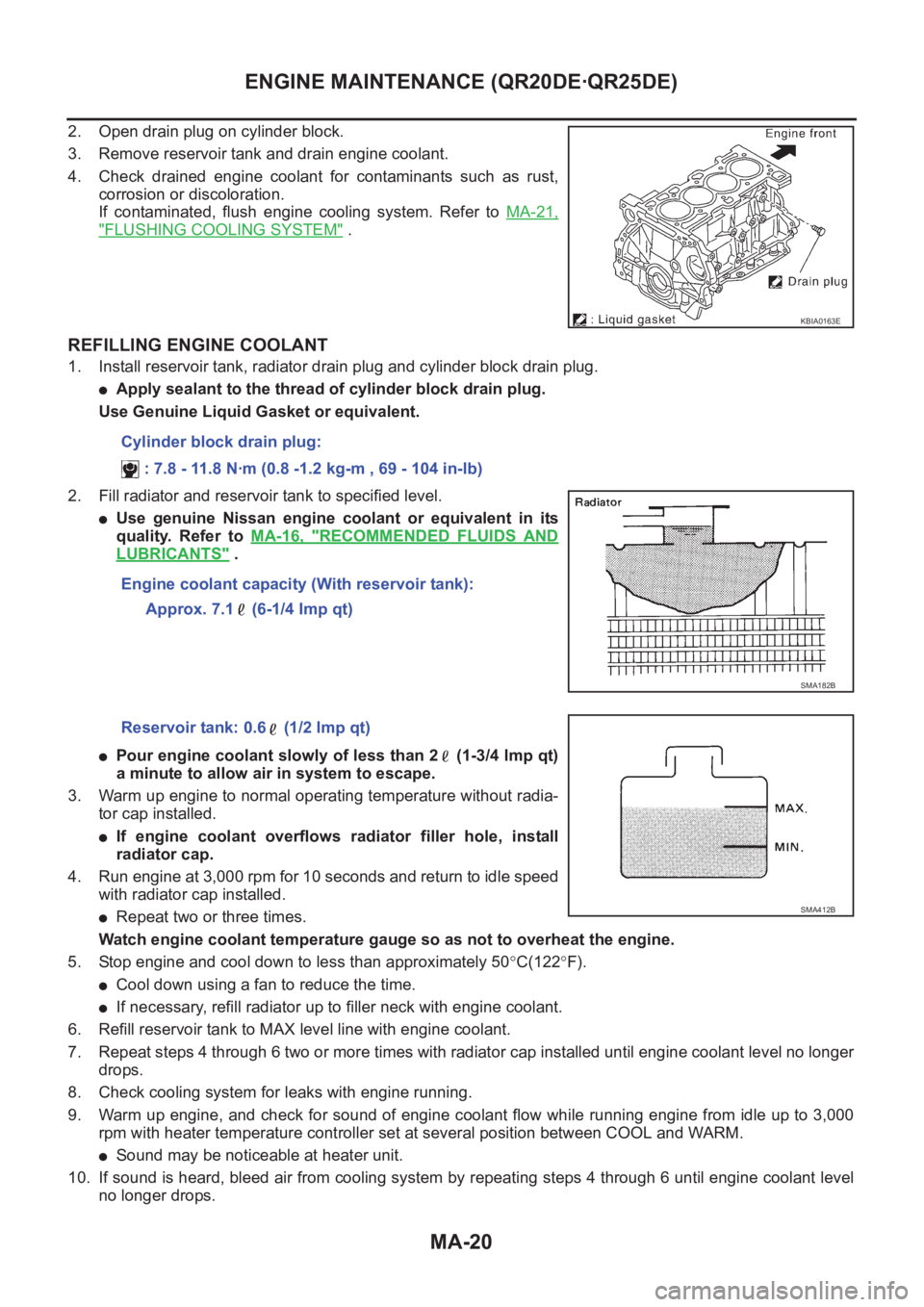
MA-20
ENGINE MAINTENANCE (QR20DE·QR25DE)
2. Open drain plug on cylinder block.
3. Remove reservoir tank and drain engine coolant.
4. Check drained engine coolant for contaminants such as rust,
corrosion or discoloration.
If contaminated, flush engine cooling system. Refer to MA-21,
"FLUSHING COOLING SYSTEM" .
REFILLING ENGINE COOLANT
1. Install reservoir tank, radiator drain plug and cylinder block drain plug.
●Apply sealant to the thread of cylinder block drain plug.
Use Genuine Liquid Gasket or equivalent.
2. Fill radiator and reservoir tank to specified level.
●Use genuine Nissan engine coolant or equivalent in its
quality. Refer to MA-16, "
RECOMMENDED FLUIDS AND
LUBRICANTS" .
●Pour engine coolant slowly of less than 2 (1-3/4 lmp qt)
a minute to allow air in system to escape.
3. Warm up engine to normal operating temperature without radia-
tor cap installed.
●If engine coolant overflows radiator filler hole, install
radiator cap.
4. Run engine at 3,000 rpm for 10 seconds and return to idle speed
with radiator cap installed.
●Repeat two or three times.
Watch engine coolant temperature gauge so as not to overheat the engine.
5. Stop engine and cool down to less than approximately 50°C(122°F).
●Cool down using a fan to reduce the time.
●If necessary, refill radiator up to filler neck with engine coolant.
6. Refill reservoir tank to MAX level line with engine coolant.
7. Repeat steps 4 through 6 two or more times with radiator cap installed until engine coolant level no longer
drops.
8. Check cooling system for leaks with engine running.
9. Warm up engine, and check for sound of engine coolant flow while running engine from idle up to 3,000
rpm with heater temperature controller set at several position between COOL and WARM.
●Sound may be noticeable at heater unit.
10. If sound is heard, bleed air from cooling system by repeating steps 4 through 6 until engine coolant level
no longer drops.
KBIA0163E
Cylinder block drain plug:
: 7.8 - 11.8 N·m (0.8 -1.2 kg-m , 69 - 104 in-lb)
Engine coolant capacity (With reservoir tank):
Approx. 7.1 (6-1/4 Imp qt)
SMA182B
Reservoir tank: 0.6 (1/2 lmp qt)
SMA412B
Page 3801 of 3833
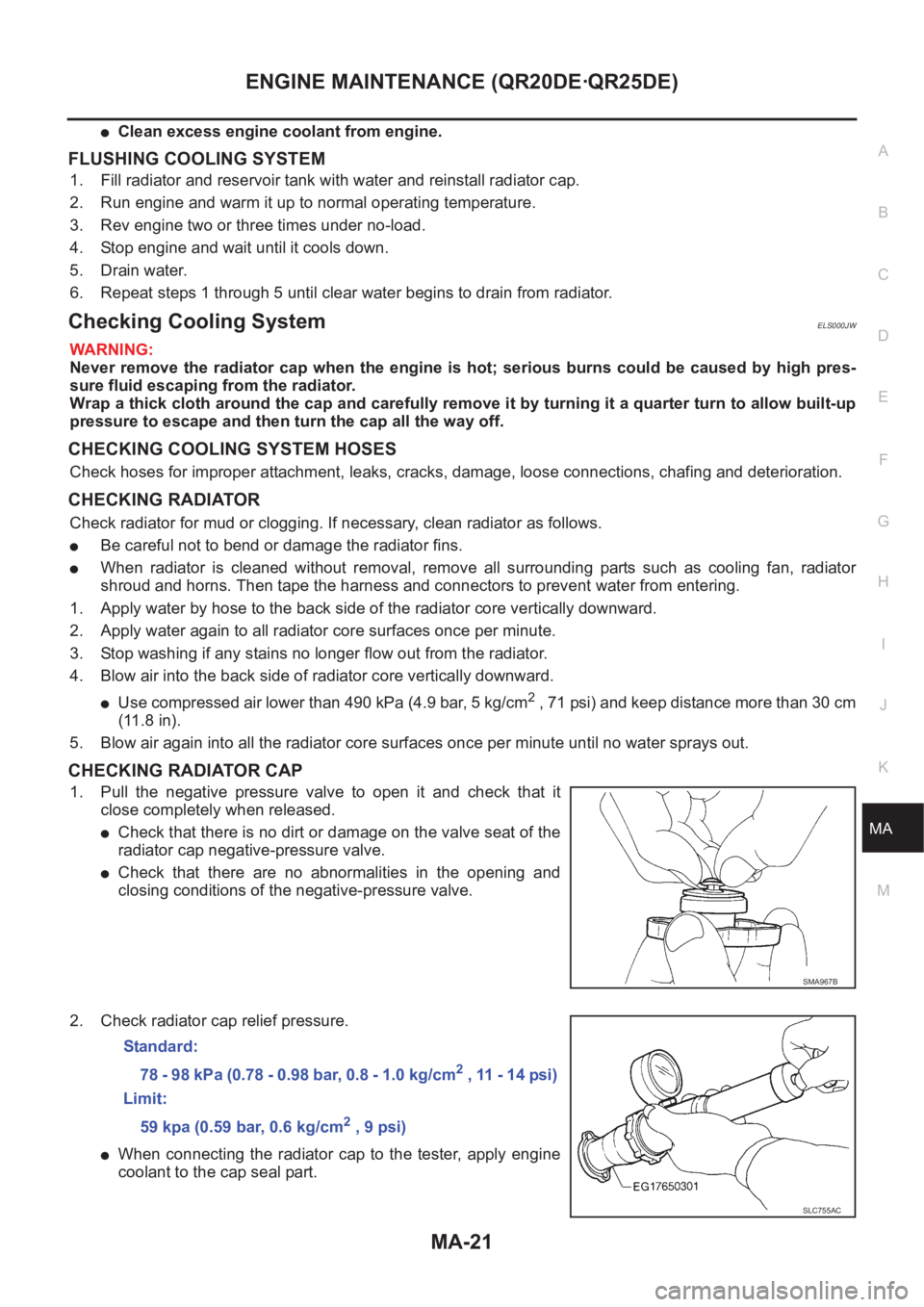
ENGINE MAINTENANCE (QR20DE·QR25DE)
MA-21
C
D
E
F
G
H
I
J
K
MA
B
MA
●Clean excess engine coolant from engine.
FLUSHING COOLING SYSTEM
1. Fill radiator and reservoir tank with water and reinstall radiator cap.
2. Run engine and warm it up to normal operating temperature.
3. Rev engine two or three times under no-load.
4. Stop engine and wait until it cools down.
5. Drain water.
6. Repeat steps 1 through 5 until clear water begins to drain from radiator.
Checking Cooling SystemELS000JW
WARNING:
Never remove the radiator cap when the engine is hot; serious burns could be caused by high pres-
sure fluid escaping from the radiator.
Wrap a thick cloth around the cap and carefully remove it by turning it a quarter turn to allow built-up
pressure to escape and then turn the cap all the way off.
CHECKING COOLING SYSTEM HOSES
Check hoses for improper attachment, leaks, cracks, damage, loose connections, chafing and deterioration.
CHECKING RADIATOR
Check radiator for mud or clogging. If necessary, clean radiator as follows.
●Be careful not to bend or damage the radiator fins.
●When radiator is cleaned without removal, remove all surrounding parts such as cooling fan, radiator
shroud and horns. Then tape the harness and connectors to prevent water from entering.
1. Apply water by hose to the back side of the radiator core vertically downward.
2. Apply water again to all radiator core surfaces once per minute.
3. Stop washing if any stains no longer flow out from the radiator.
4. Blow air into the back side of radiator core vertically downward.
●Use compressed air lower than 490 kPa (4.9 bar, 5 kg/cm2 , 71 psi) and keep distance more than 30 cm
(11.8 in).
5. Blow air again into all the radiator core surfaces once per minute until no water sprays out.
CHECKING RADIATOR CAP
1. Pull the negative pressure valve to open it and check that it
close completely when released.
●Check that there is no dirt or damage on the valve seat of the
radiator cap negative-pressure valve.
●Check that there are no abnormalities in the opening and
closing conditions of the negative-pressure valve.
2. Check radiator cap relief pressure.
●When connecting the radiator cap to the tester, apply engine
coolant to the cap seal part.
SMA967B
Standard:
78 - 98 kPa (0.78 - 0.98 bar, 0.8 - 1.0 kg/cm
2 , 11 - 14 psi)
Limit:
59 kpa (0.59 bar, 0.6 kg/cm
2 , 9 psi)
SLC755AC
Page 3802 of 3833
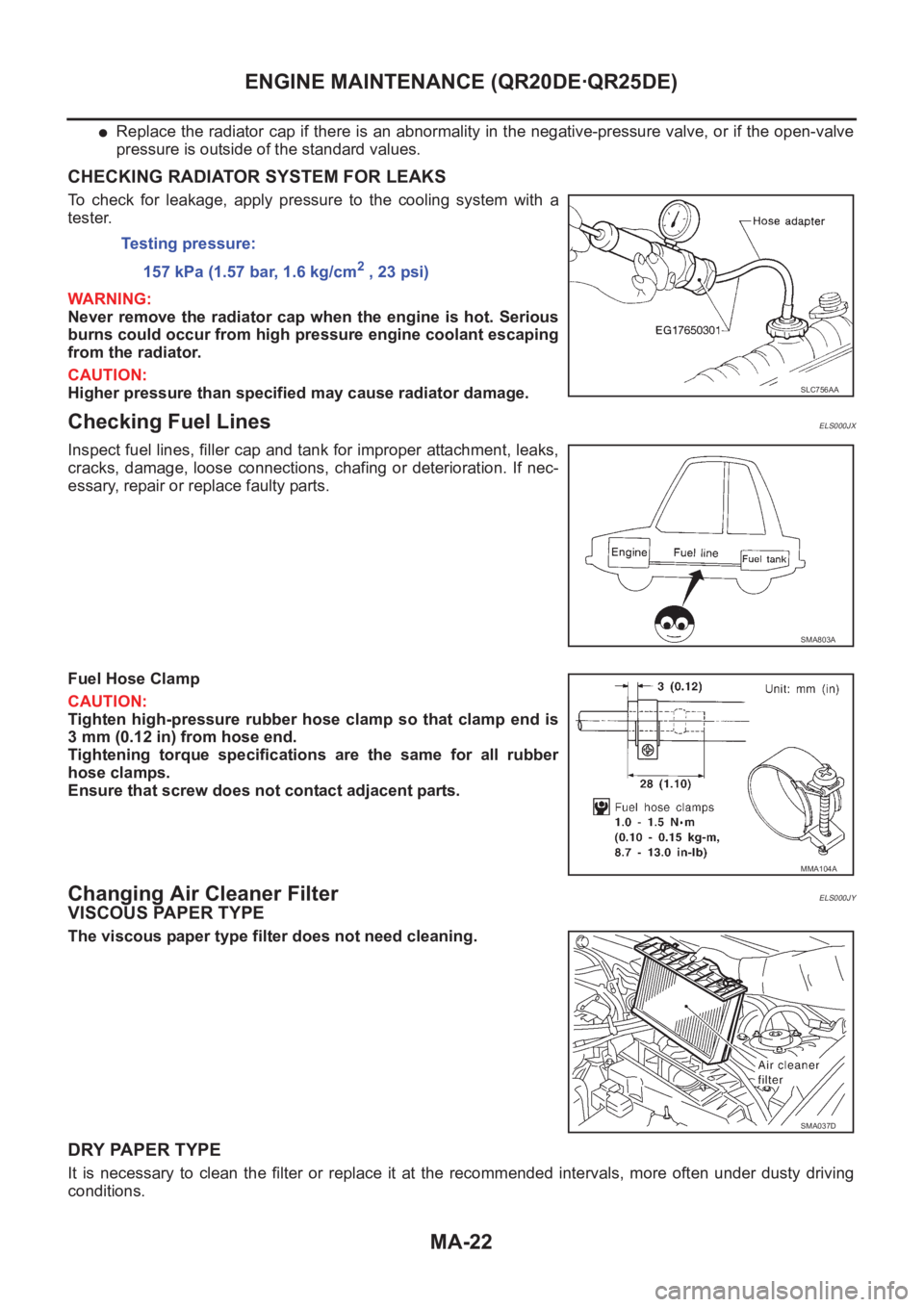
MA-22
ENGINE MAINTENANCE (QR20DE·QR25DE)
●Replace the radiator cap if there is an abnormality in the negative-pressure valve, or if the open-valve
pressure is outside of the standard values.
CHECKING RADIATOR SYSTEM FOR LEAKS
To check for leakage, apply pressure to the cooling system with a
tester.
WARNING:
Never remove the radiator cap when the engine is hot. Serious
burns could occur from high pressure engine coolant escaping
from the radiator.
CAUTION:
Higher pressure than specified may cause radiator damage.
Checking Fuel LinesELS000JX
Inspect fuel lines, filler cap and tank for improper attachment, leaks,
cracks, damage, loose connections, chafing or deterioration. If nec-
essary, repair or replace faulty parts.
Fuel Hose Clamp
CAUTION:
Tighten high-pressure rubber hose clamp so that clamp end is
3 mm (0.12 in) from hose end.
Tightening torque specifications are the same for all rubber
hose clamps.
Ensure that screw does not contact adjacent parts.
Changing Air Cleaner FilterELS000JY
VISCOUS PAPER TYPE
The viscous paper type filter does not need cleaning.
DRY PAPER TYPE
It is necessary to clean the filter or replace it at the recommended intervals, more often under dusty driving
conditions.Testing pressure:
157 kPa (1.57 bar, 1.6 kg/cm
2 , 23 psi)
SLC756AA
SMA803A
MMA104A
SMA037D